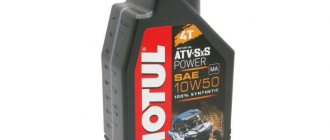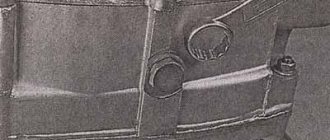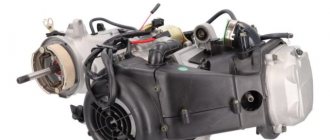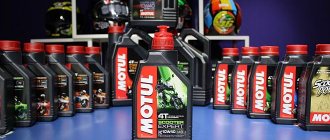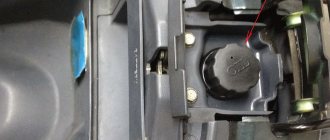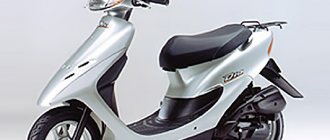Changing the engine oil
In 2-stroke technology, the oil does not change, but is regularly poured into a separate tank and supplied by an oil pump to the carburetor, where it is mixed with the air-gasoline mixture and supplied to the engine.
The mixture lubricates the rotating and rubbing parts of the engine, burns and exits with exhaust gases into the exhaust pipe.
Oil tanks on scooters have different volumes - from 0.6 l to 1.3 l.
One liter of oil is enough for about 1000 km.
If you ride a motorcycle every day, then five liters of oil will be enough for a 2-stroke engine for the summer season.
The Oil lamp on the instrument panel indicates that the oil has dropped to the reserve level.
If the lamp lights up, it means that there is little oil left in the tank.
You should not take risks and drive with the Oil light on, because as soon as the oil runs out completely, the engine will overheat and seize.
We'll have to capitalize on it. And this, you understand, is time-consuming and expensive repairs.
On 4-stroke 50 cc motorcycles, the oil is changed every 2 - 3 thousand km. During this mileage, fuel combustion substances accumulate in the oil and, as a result, it becomes dirty and thick, which changes its structure and properties.
If you drive together, transport cargo, that is, when the engine often works under heavy loads, then change the oil more often, after 1 - 1.5 thousand km.
Let's get down to business.
Start the scooter for 5 - 10 minutes. until the increased speed drops.
Place the motorcycle on the stand and turn off the engine.
Loosen the drain bolt.
Place a liter jar to drain the waste and unscrew the bolt completely.
Then unscrew the oil dipstick.
In 5 minutes, all the oil will flow out of the engine.
On a Honda Dio 56, there is a filter mesh under the oil drain cover. Wipe it well with a dry cloth and blow it or rinse it in gasoline.
On a Honda Dio 68, the oil filter mesh is located near the variator. The mesh also needs to be removed and washed.
Then reassemble everything in reverse order.
For the summer season, buy an oil with a high viscosity that is universal for any temperature, for example, 10w40.
Fill the engine with oil through the dipstick. Its quantity depends on the motorcycle model and is indicated on the oil dipstick.
The level should be up to the top mark of the dipstick.
As you can see, the procedure is not complicated, but it requires care and will take 20–30 minutes. It's always difficult to start the first time, but then it will be business as usual for you.
Tests and Reviews
CF Moto v3 - motorcycle or scooter? How is it? The V3's style is sporty, European and eye-catching. Reminds one of
Gilera Runner 180 FX-R (1998-2002) First of all, this scooter can be recommended to active people with sports
Honda Lead With this model we begin our acquaintance with scooters that have already had a good reputation
Honda Lead 100cc After an old Japanese fifty-kopeck car, you always want something more powerful
Honda Lead 90 Honda Lead 90 is the most popular scooter with a displacement of more than 50 cc on the used market
Peugeot presents the Speedfight 3 scooter French Peugeot presents the Speedfight 3 scooter for the 2009 model year. This is the last one
Yamaha Axis 50 We continue to talk about the most interesting models of the Russian secondary market. On the wave
Yamaha BW'S 100 Essentially, it’s a reincarnation of the Aegox 100 in an “off-road type” form. Looks great
[Generated in 0.077 seconds, 12 requests completed]
Changing the oil in the gearbox
From our experience, we recommend using 75W90 oil; replacement should be done after 5 - 6 thousand km.
On all Suzuki and Yamaha models there is a drain bolt on the gearbox.
Place a wide bowl under it.
Unscrew two bolts: filler and drain.
Drain the waste - it will be 90 - 120 ml.
Tighten the drain bolt.
Place a tube on the syringe and pump oil into the gearbox to the level of the plug.
Tighten the filler bolt.
Therefore, drain the waste through the filler hole, tilting the scooter to one side.
To drain the waste, take a flat container or place an open plastic bag with a rag inside.
Then place the scooter on the stand and use a syringe with a tube attached to fill in the oil until it flows out.
Install the filler bolt and tighten slightly.
Working with the gearbox turned out to be even easier than working with the engine. Therefore, do not be afraid, try and service your motorcycle on time, at the required mileage, in order to ride longer without repairing the gearbox.
Subscribe to our blog. Don't miss the next article on carburetor cleaning and tuning.
Source
see also
Comments 3
“The woman didn’t have a hoot, but the woman bought a pig,” but on the other hand, if a person likes to “tighten nuts” (someone generally collects stamps or just drinks), then it’s quite a normal activity in his free time from his main job. ps I had candles with such red soot when we had 95 at gas stations using additives. 5-10 t.km. and a furry animal came to visit the platinum candles, the candles cost $60 for a set (four pieces) and/or $180 for two coils if you flapping your ears. So until 2014 (until I bought a Nissan) I drove 92. The spark plugs on the Nyuska cost like a bucket and I decided to try filling in 95, it turned out that now they don’t burn. I refuel both in Belarus and in the Russian Federation only with Lukoil.
here there are only 92, I only fill up at good gas stations, there will be a recording ahead of what happened to the new spark plug after 400 km... you'll see))))
see also
Comments 3
“The woman didn’t have a hoot, but the woman bought a pig,” but on the other hand, if a person likes to “tighten nuts” (someone generally collects stamps or just drinks), then it’s quite a normal activity in his free time from his main job. ps I had candles with such red soot when we had 95 at gas stations using additives. 5-10 t.km. and a furry animal came to visit the platinum candles, the candles cost $60 for a set (four pieces) and/or $180 for two coils if you flapping your ears. So until 2014 (until I bought a Nissan) I drove 92. The spark plugs on the Nyuska cost like a bucket and I decided to try filling in 95, it turned out that now they don’t burn. I refuel both in Belarus and in the Russian Federation only with Lukoil.
here there are only 92, I only fill up at good gas stations, there will be a recording ahead of what happened to the new spark plug after 400 km... you'll see))))
Honda AF-56 maintenance, please tell me.
#1 Alexsey
I purchased this moped last fall. Like 2004 release. The speedometer shows 5000 km, probably on the second circle, the front fork is completely destroyed and needs to be replaced. For those who don't know, this is a 4T water-cooled scooter. Actually these are the main questions:
1) What kind of oil should I pour into the engine? In the store, the seller said that before selling it he had filled it with some Energy 10W40, that is, semi-synthetic, but he already found out that it was not very good. They offer to pour Hado, synthetics for 80 UAH per liter. Who knows, tell me what kind of oil is best to fill here so that it is of good quality.
Recommendations for proper use of scooters
Evgeniy Excellent oil! There is something to compare with. The oil is really low smoke. Very satisfied! Thank you for your work! Yuri XADO products to help motorists. Alexander Oil is truly of the highest quality. Mikola Good afternoon!
Expert answer: Maxim Expert answer: In stock. Alexander took 2 liters of this oil to add to the solarium. I think it won’t be worse, because the manufacturer is reputable. Evgeniy The saw is new and has never been used. Expert answer: Konstantin Good afternoon, tell me, can this oil be added to diesel oil?
Use safely in the proportion of 1 liter of fuel - 20g. Nikolay Poddubsky Everything is high quality and fast, an excellent online store. Victor Chotiri rocked back by buying a Chinese chainsaw, the cheapest one for UAH. Eduard What is the ratio of this oil to fuel?
Dmitro Everything is super, bistro delivery. Alexey Tell me, is it possible to pour this oil into a Java box? Or recommend something else! Expert answer: Feel free to pour this oil into the nuclear power plant.
Other answers in this thread
#2 Alexsey
Actually these are the main questions:
2) Which front fork is better? They offer the same one as before, a spring Honda, Taiwan. You can also go to China, but they say it’s worse. Is it possible to install a Honda or other good hydraulic fork here?? The mechanic says that all hydraulic forks for Hondas have disc brakes (I have drum brakes). Yes, you can also put a repair kit on this fork, but as I already found out, it will last for about a season and is not the best option. Tell me what to do?
3) The scooter travels for a maximum of 50 km, but it’s the same whether it’s going up or down the mountain, that is, there is some crap in the engine, you can feel it, the traction is good. Is it worth playing with rollers to increase the speed? They say if you put the rollers at a high max. speed then the traction will be lost. And the fact that right now I have Japanese videos, factory ones, but they are sold in worse quality. How much will I receive in max. speed if I set it to max. speed rollers?? And what are they anyway, in terms of speed/traction??
Scooter rider
Everyone who takes the path of a motorbike enthusiast is faced with the problem of choosing and changing oil for a scooter or motorcycle. While some people change it immediately after purchase, others travel several thousand kilometers and only then change the oil. But there are also those who do not change it at all; this, of course, does not last long. To choose which oil is suitable for your scooter, you need to know the type of engine of your scooter. There are two-stroke (2t) and four-stroke (4t) scooters. Accordingly, there is oil for 2t and 4t scooters. For each of them there are three types of oil: mineral, synthetic and semi-synthetic. Let's decide on the type of oil that suits your scooter. To do this, determine the type of engine: two-stroke or four-stroke. After this, you can start making your selection.
What kind of oil to fill in Honda Dio
On the instrument panel (Fig. 1) there are:
rice. 1
In addition, the panel may contain a low and high beam indicator.
The instrument panel has a backlight, which is turned on, depending on the model, when the engine is running with a switch in three positions: “off”, “backlight”, “light”, or simply when the engine is on (there is no switch).
The speedometer is connected via a cable to the front wheel.
The oil indicator (5) lights up when the engine oil runs out.
Control knobs and buttons (Fig. 2) include:
Rice. 2
The left handle operates the brake of the rear wheel, and the right handle brakes the front wheel. In addition, the starter button is only activated when the left or right brake handle is pressed with the ignition key in the l ON ╗ position.
The low-high beam switch controls the headlight, which turns on, depending on the model, or simply after starting the engine, if there is no three-position light switch (according to traffic regulations, headlights must be turned on even in daytime), or by turning the three-position light switch to the extreme left position when running engine. When the high beam is on, the high beam indicator on the instrument panel turns on.
The turn signal switch has three positions: left turn, right turn and neutral position. To go from on to neutral, just press a button.
The accelerator handle, through a cable, simultaneously controls the carburetor air damper and the oil supply lever in the oil pump, coordinating the oil supply in accordance with fuel consumption in the required proportion.
Egnition lock.
The ignition switch has 3 positions:
l OFF ╗ – “turned off”, l ON ╗ – “turned on” l LOCK ╗ – “closed”.
In the l ON ╗ position, all electrical equipment begins to work and, in addition, the key is locked in the ignition switch to prevent it from accidentally falling out. In position l OFF ╗ the electrical equipment is turned off and the engine is turned off. In the LOCK ╗ position, a mechanical anti-theft device is latched, blocking the steering wheel rotation. In the l OFF ╗ and l LOCK ╗ positions, the key is removed from the ignition switch.
Starting the engine and starting to move.
There are two ways to start the engine: using a starter and using kick starting.
In the first case, you need to turn the ignition key to position LO N ╗, press one of the brake levers, preferably the left one) and press the starter button.
In the second case, put the mokick on the step, turn the ignition key to position l ON ╗, and start the engine using kick-start (Fig. 3).
rice. 3
When starting the engine, it is necessary to take into account that the torque from the engine to the rear wheel is transmitted through the variator and automatic clutch, which is activated at high speeds. And, if for some reason the initial engine speed when starting it is high, there is a danger of spontaneous movement of the engine
.
This is why it is necessary to place the mokick on a stand during the second launch method. And in the first case, the starter button is locked with the brake handle. rice. 4
| To remove the mokick from the footrest, it is necessary, while supporting the left brake handle, to push the mokick slightly forward (Fig. 4). |
rice. 5
| To start moving, you need to put on a helmet, sit on the motorcycle (Fig. 5) and start moving, gradually increasing the engine speed with the accelerator handle. |
Technical operation.
During operation, the following points must be taken into account:
The durability of the piston group depends on the quality of the air filter, therefore, unscrew the screws (Fig. 6), remove the foam filter (Fig. 7), if necessary, wash it in gasoline and put it in place.
rice. 6 fig. 7
In this case, check especially carefully whether there are any tears in the filter itself and how tightly the filter fits in its seat. The operation of the piston group, as well as the engine bearings, depends on the supply of oil mixed with fuel in the carburetor. If the oil indicator lights up on the instrument panel, it indicates that it is necessary to add oil to a special tank. In addition, it is necessary to control the condition of the lever in the oil pump (its location is such that there is a high probability of contamination with road dust mixed with oil vapor, which leads to sticking of the lever in the maximum oil supply mode, and this leads to an over-enrichment of the fuel mixture with oil, leading to poor combustion , smoke and other negative consequences.
The presence of oil in the oil tank does not mean that everything is in order with the oil supply. If for some reason an air or dirt plug has formed in the oil supply hoses, then the piston group can be cleaned in a matter of minutes. This danger arises especially when the mokika is idle for a long time.
To control and replace the transmission oil, the gearbox has a drain plug (Fig. and a filler plug (Fig. 9). Oil is filled to the level of the filler plug.
and a filler plug (Fig. 9). Oil is filled to the level of the filler plug.
rice. 8 fig. 9
It is also necessary to monitor the air hose connecting the gearbox housing to the air filter housing. If for some reason the hose has jumped out of the air filter housing, then there is a danger of dust or water getting into the crankcase.
Brake system.
The rear drum brakes are activated using the left brake lever and are adjusted with a special nut for the profile (Fig. 10).
rice. 10 pics. eleven
By the position of this nut you can judge the degree of wear of the brake pad. In addition, the rear brake is locked for convenience. To do this, you need to press the left brake and lock it with the lever (Fig. 11)
rice. 12
| Front brakes can be drum or disc type (Fig. 12). In the second case, force is transmitted from the right brake lever by brake fluid through the brake hose. The brake fluid is monitored through a special window, topped up if necessary by unscrewing the top cap, and the brake system is bled in the same way as bleeding the brake system of a car. |
Wednesday, March 7, 2012
The choice of oil for the engine of a Chinese fifty-kopeck scooter or a Japanese 4t used air-cooled scooter.
Today we will look at which oil to choose for our 50cc air-cooled scooter. The problem for scooterists is that in the summer, the engine of their scooter often overheats and it “seizes,” or such an unpleasant thing happens that the cylinder-piston group of their scooter does not last long (3-5 thousand kilometers). You may ask, what is the problem with this scooter problem? Most often the problem is poor or low-quality oil. Either it’s because the scooter isn’t serviced enough or they don’t know that it needs to change the engine oil. You need to change the engine oil once a season or once every 1000-1500 kilometers. Firstly, never pour mineral oil, this will immediately ruin the engine. Yes, adding oil for 50 rubles a liter is a good financial option, but not good for your engine. Let's start with the fact that I advise using only synthetic oil. Engine crankcase 139QMB and similar Japanese 50cc engines approximately 800 ml. So a liter can of oil is enough for you to fill it once into the scooter and just add oil for this thousand kilometers. You may say, but there are so many oils, which one should you choose? And why did I say be sure to change the oil at least once a season? Each oil has its own viscosity index, this is the number at which the oil turns into liquid and loses its properties. For example, 5W-50 oil. In this case, the number 5 is the oil viscosity index calculated “for frost,” that is, at what minimum temperature the oil will turn into useless. That is, over the winter the oil has time to deteriorate, since it is not normally used, unlike a car, where the engine operates even in winter in different operating modes. So during the winter only oil with the first number 20 or more will not have time to deteriorate. The second number 50 is the maximum temperature index, after which the oil turns into liquid and the engine just “jams.” I’ll give an approximate overheating table. 40 – 100 degrees Celsius 50 – 120 degrees Celsius 60 – 140 degrees Celsius Usually, it is recommended to pour oil with a viscosity index of 40 into a scooter engine, the argument being that the engine is low-speed. Don't fall for these tricks! The thing is that the operating temperature of the engine is 90 degrees Celsius, it’s just 10 degrees short of overheating in 40 oil. But bad luck, you use a 50cc scooter almost constantly with the gas to the floor because its power is small for the traffic flow. Accordingly, in the summer, when there is a traffic jam and jerking the gas, or pressing the gas to the floor, catching the wedge does not seem to be a problem. Therefore, in a stock configuration or only when adding a 72cc piston group to a 139QMB engine, you can pour oil with an index of 50. The question immediately arises of what brand of oil to pour. Well, of the tested ones, I recommend Mannol Liqui-Moly Castrol Motul The first is famous for its price, although it has good quality, the second is an average contender, the third is expensive but the best quality. The fourth is famous for its good motorcycle oils, but... a lot of fakes. I choose Mannol. If you are a butcher, or drive a lot, or just want to play it safe, choose an oil with an index of 60. Of these oils, I choose Castrol oil. 10W60 Racing. There is such an oil manufacturer - Hado, never buy oils from this manufacturer, you will get 90% of the engine wedge or greatly reduce the engine life. Semi-synthetic Lukoil oils have recently appeared. I myself do not recommend semi-synthetics, but often in the regions and even the Moscow region there is simply no good engine oil or it is not certified (that is, scorched, and such oil will 100% kill your engine). Lukoil oils have proven themselves well in the oil market. So, let's summarize. When buying oil, always ask for a certificate; if there is none, it is better not to buy this oil, there is a high chance that you will get a fake. If you live in the region or Moscow region and you do not have the opportunity or finances to buy good synthetic oil in Moscow, take 5W50 Lukoil semi-synthetic engine oil. For synthetics, I recommend 5W50 Mannol (about 180 rubles per liter) and 10W60 Castrol (400 rubles per liter). Never try to keep up with freebies and under no circumstances pour transmission oil into the engine. Don't forget about certificates when purchasing! Good luck on the roads!
1 comment:
The author's incompetence is amazing. The phrase “For example, 5W-50 oil. In this case, the number 5 is the oil viscosity index calculated “for frost,” that is, at what minimum temperature the oil will turn into useless. That is, over the winter the oil has time to deteriorate, since it is not normally used, unlike a car, where the engine operates even in winter in different operating modes. So during the winter only oil with the first number 20 or more will not have time to deteriorate.” This is nonsense. The author does not know the crystallization and flash temperatures of the oil!

